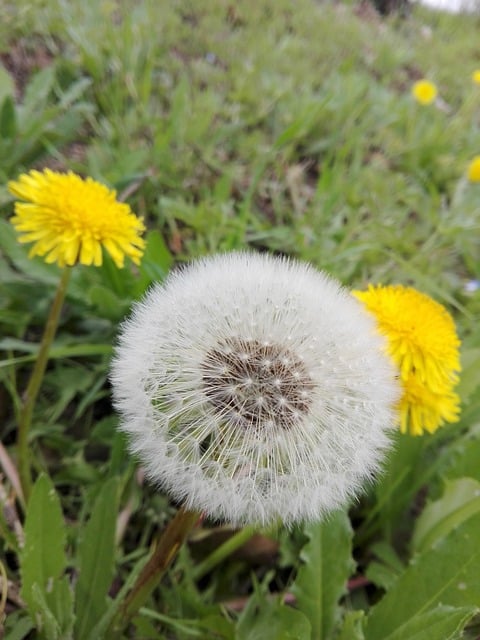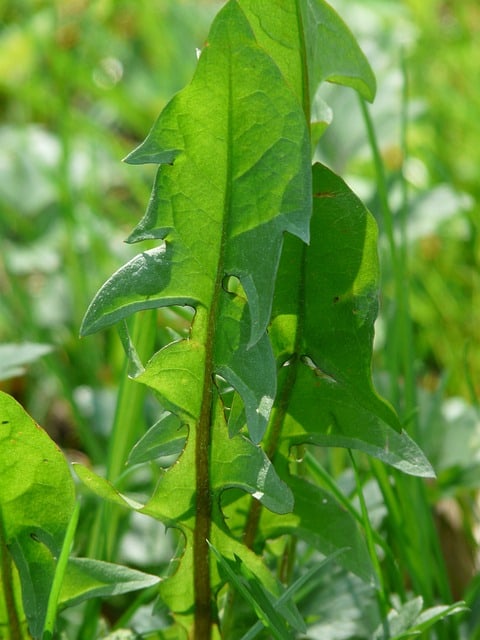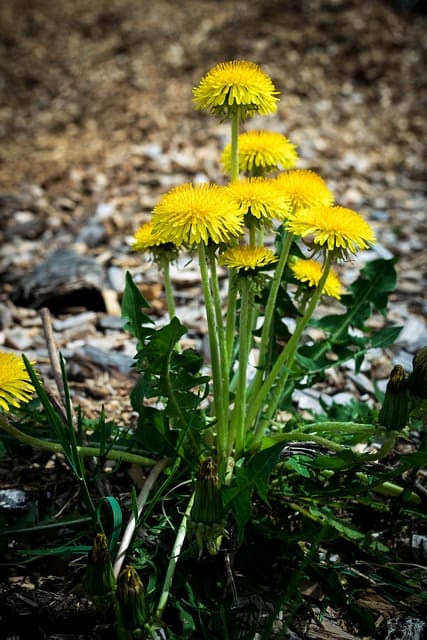The homeowners of North America are very familiar with the bright yellow flower known as the dandelion. Considered an irritating weed, many people invest time and money in weed killers to clear their lawns of the pest. At the same time, however, there are plenty of people who look at dandelion flowers not only as something pretty and cute but as something edible. Consuming dandelions sounds like something only a fringe group of people may do, but it’s actually fairly common, and something humans have done historically. But are they any good? Should we be eating dandelions? And how?
Are Dandelions Edible Raw?
Yes, dandelions are edible raw, or cooked, with the caveat that you want to be sure you aren’t eating dandelions that have been treated with weed killer.
Dandelions can be served in many ways. Dandelion wine and tea are popular, and they’re a great addition to pesto or stir fry. Eaten raw, dandelions are often served in salads. Every part of the dandelion is edible raw. People enjoy eating the entire plant, including the dandelion blossoms, leaves, and roots. Depending on the parts of the dandelion you’re eating, you may be benefiting from different nutrients and definitely experiencing different flavors.
The yellow flower heads are the most flavorful. They are sweet and pack a fun punch to a salad. The green part behind the blossom is edible but has a bitter flavor. The dandelion leaves add a fun bit of spice to a salad, particularly when they are younger. As the leaves age, they become bitter greens. The roots have an earthy flavor. Many people make dandelion tea using the roots and enjoy it as an alternative to coffee, especially when they are working to break a daily coffee habit. People do also pinch off dandelion seeds and eat them, sometimes turning them into milk. This should be done while being mindful of the fact that they are a natural diuretic.

Is It Safe To Forage For Dandelions?
Whether in your own yard or out on a trail, it is generally safe to forage for dandelions. As a plant, they are safely edible. Always keep in mind that in recent decades these flowers have been considered an irritant, so many homeowners regularly use weed killer on these plants. Make sure that you are harvesting dandelions that you know haven’t been treated with weed killer. Eating dandelions treated with weed killer is not advisable.
You should also avoid dandelions that are growing along the roadside. This is because the flowers will have been heavily exposed to exhaust and other pollutants that the plants will have picked up, so the plant itself will have these chemicals inside. When foraging for dandelions, you want them to be growing in a healthy place.
If you’re concerned about cleaning the dandelions free of bugs, you may want to put your freshly foraged plants into a bucket. When you’re ready to clean them, put a small amount of white vinegar in the bucket with the flowers and a lot of water. Stir the plants around a bit to get them cleaned off.
As with any plant you are foraging, you need to be one hundred percent certain that you are actually picking dandelions. If the plant hasn’t blossomed yet, it may be easier to confuse dandelion leaves for another plant. To be sure that you are foraging dandelions, the first step is to check at least two sources that you trust. Take a careful look at the leaves and compare them with your sources. Then, you can do an edibility test. This will include eating a leaf and then waiting two hours to be sure you don’t have any ill effects, like an allergic reaction to a leaf that isn’t actually from a dandelion plant. When it comes to foraging fresh food, it’s always better to be safe than sorry.
When Should Dandelions Be Harvested?
The best time to harvest dandelions is in the early spring, particularly in the early morning. Dandelion leaves become more bitter the older they are. In the early spring, before the plant even begins to flower, is when the leaves are at their most tender.
Can You Buy Dandelions At The Grocery Store?
Yes, you can buy dandelion greens at the grocery store. They’re most often sold at small specialty stores and can be found in the cooler area of the produce section. Keep in mind that dandelions tend to be more expensive at the grocery store than other salad ingredients you buy. Many people only report paying approximately four American dollars for a handful of dandelion. While more costly than expected, purchasing them at the grocery store is an easy option if you don’t have dandelions growing readily around you.
What Are The Health Benefits Of Dandelions?
One of the benefits of dandelions is that their leaves come packed with a healthy dose of vitamins. Dandelion leaves have vitamins A, vitamin K, and vitamin C. This nutritional plant is also heavy with antioxidants, which protect against free radicals.
Some studies have shown that dandelions may boost the immune system, suggesting they have antiviral and antibiotic properties. Other studies have suggested that dandelion extract or tea has lowered triglyceride levels, which can have a positive effect in preventing heart disease.
In herbal medicine, dandelions have commonly been used for their diuretic effect, particularly in dandelion tea.
While their nutritional value is great, and dandelions are generally safe to eat, and quite enjoyable as leafy greens in a simple salad, there are some people who will want to avoid dandelions. For example, people with diabetes, people with gallbladder problems, and people taking blood thinners should avoid dandelion, especially in more concentrated extract forms. If you are already taking a diuretic, you will also want to avoid dandelion, as this may dangerously increase the effects.
Are People Allergic To Dandelions?
There are reports that suggest people with conditions like asthma may have allergic reactions following exposure to airborne dandelion pollen. However, that doesn’t seem to be a common issue. While dandelion seeds are often seen blowing in the wind, they are too heavy to bother most people’s allergies. There isn’t much evidence to suggest that eating dandelions have caused allergic reactions.


How Do People Serve Dandelions?
If you have recipes where you’re using leafy greens, you can probably add dandelions to the mix to add some different flavor to your meal.
Dandelion roots don’t have much flavor on their own, but can be added to a mix with other root vegetables, roasted, and happily enjoyed.
The entire plant can be cooked in a frying pan with some olive oil and lemon juice and made into a great addition to your meal.
Raw dandelion greens can be added to salads.
More adventurous cooks have turned the flowers into dandelion fritters, adding flour, cornmeal, and spices before cooking up a couple of cups of the blossoms. The fritters will have a mild but slightly bitter flavor that’s fairly unique.
Dandelion pesto may be more bitter than traditional pesto but is a unique and fun addition to a meal. One of the best parts about pesto is that it’s fairly easy to make from scratch but tends to impress people when you serve it up as something they can spread on toasted bread or eat in a pasta dish. To make dandelion pesto, you’ll need to puree raw dandelion greens and then add pine nuts and olive oil.
Many cooks will also toss some dandelions into stir fry that can use a mildly bitter addition to the mix.

Dandelions Are An Overlooked Wild Edible Plant
It’s amazing how dandelions have built a reputation as a weed out to ruin people’s neatly trimmed lawns when in fact, they have so much to offer as an edible and nutritious plant. The common dandelion (called taraxacum officinale) has a lot of versatility. The roots can be made into tea, extracts, or even dandelion coffee. They can also be roasted with other root vegetables for a hearty addition to the meal. The leaves can be pan-fried with some olive oil or tossed in a salad. The blossoms make a sweet treat eaten raw on the trail, a great addition to any salad, or can be made into something as unusual as dandelion fritters. And better yet, not only are all these parts of the dandelion edible, but the entire plant is packed full of nutritional value. It’s surprising that this weed isn’t eaten more often in North America with how much it has going for it and how readily available dandelions are. However, because the brightly colored flower is so noticeable, it’s easy to see how it could be considered a flaw in a front lawn meant to be one solid square of green.
For those interested in eating dandelions, be sure that you are correctly identifying the plant, and that you know the weed hasn’t been treated with any chemicals. Forage safely away from any roadways where the plant could have grown up in exhaust fumes. When you’re sure you have a safe-to-eat plant, have fun experimenting with these readily available edible plants.
Recent Posts
The only venomous snakes in Washington State are Northern Pacific Rattlesnakes. The Northern Pacific Rattlesnake (Crotalus oreganus oreganus) is a sub-species of the Western Rattlesnake. Anyone...
Skunks are not classified as true hibernators. But they go into a state of torpor when the weather gets cold. Skunks are light sleep hibernators, along with opossums, bears, and raccoons. ...

